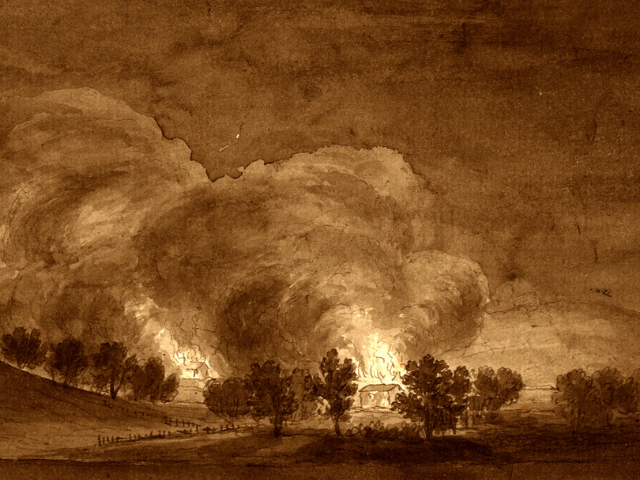
Eighteenth-Century Farm Burning (New York Public Library). Bloody Bill Cunningham terrorized South Carolina's backcountry in a campaign called "The Bloody Scout." He and his men committed massacres and murders including the firey destruction of Wofford's Iron Works.
(? - 1787) William first appeared in South Carolina in the 1760s. At the outset of the Revolution, Cunningham sided with the patriots and served in the militia force that marched on the frontier post of Fort Charlotte in 1775 and in the Cherokee expedition of 1776. According to legend, Cunningham developed a relentless animosity for all patriots in 1778 after the murder of his invalid brother by backcountry Whigs.
When the British gained control of South Carolina in mid-1780, Cunningham enlisted in the provincial militia forces under the British major Patrick Ferguson. After the evacuation of Ninety Six by the British the following summer, Cunningham mustered a company of some forty men and, from a base camp in the Blue Ridge Mountains, led them on forays into the South Carolina backcountry. Rewarded with a promotion to major, Cunningham filled the ranks of his unit to some three hundred strong and set out in late autumn 1781 on an expedition that would become known as the “Bloody Scout.”
Advancing to the upcountry from Charleston, Cunningham’s main force overtook and attacked a small party of thirty militia under the command of Captain Sterling Turner at Cloud’s Creek on November 17, 1781. Cunningham ordered that no quarter be given after learning that Turner’s force was responsible for the death of a Tory captain. After defeating Turner, Cunningham pressed on to attack a small post commanded by Colonel Joseph Hayes on the Little River only two days later. Hayes, with a handful of defenders, offered a stubborn resistance but was eventually forced to surrender. Cunningham apprehended Hayes, who reportedly still possessed a proposal of humane treatment from Cunningham in his hand, and hanged him and his executive officer. When the pole they were using as gallows broke, the Loyalists were said to have hacked Hayes and Williams to death with swords and then to have killed twelve more of the prisoners.
Cunningham began a retreat toward Charleston after learning that elements of militia forces led by Andrew Pickens and Thomas Sumter were converging on him. Retreating into the swamps near Orangeburg, Cunningham managed to elude the patriots and return to Charleston. He continued to lead raids into the South Carolina interior throughout 1782 but fled to the safety of East Florida shortly before the British evacuated Charleston in December. Still, reports of “Bloody Bill” leading incursions continued to circulate, and in 1783 the General Assembly enacted legislation intended to capture him and other “notorious offenders who disturb the peace.” Spanish authorities expelled Cunningham from East Florida in 1785, claiming that he was involved in looting along the St. Mary’s River. He died in Nassau, Bahamas, on January 18, 1787.


